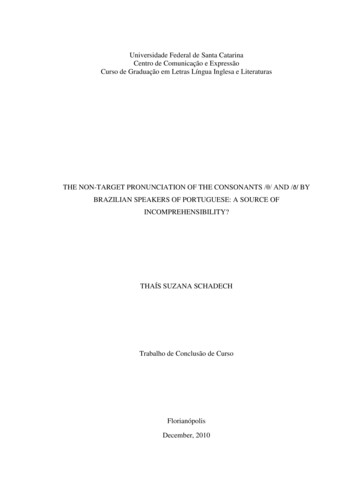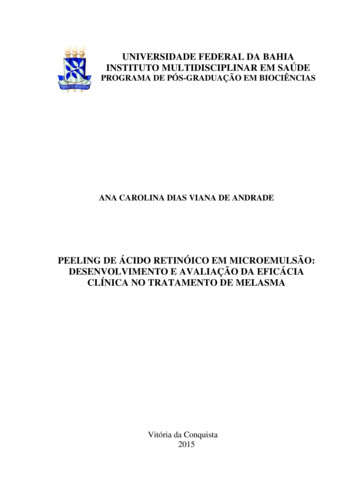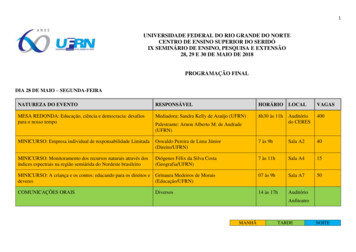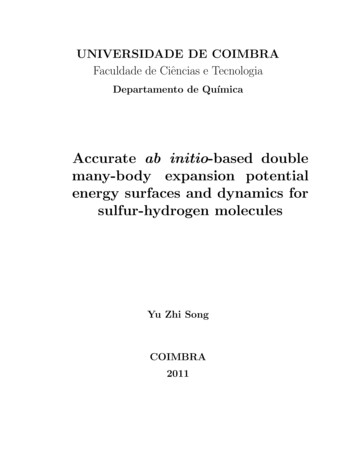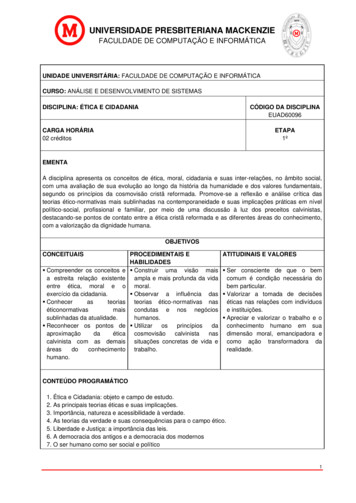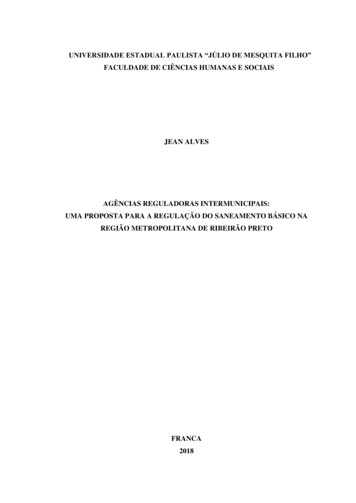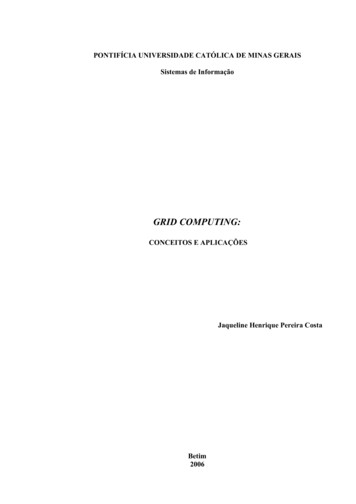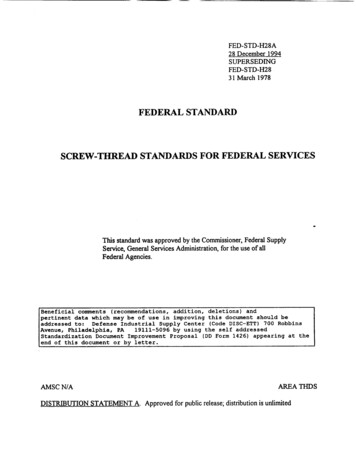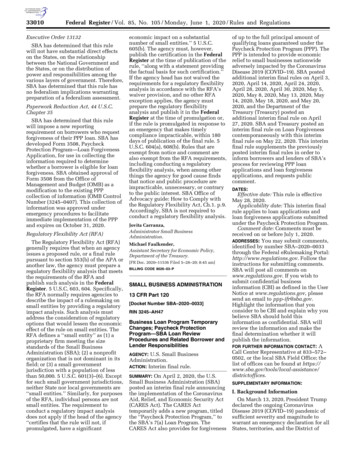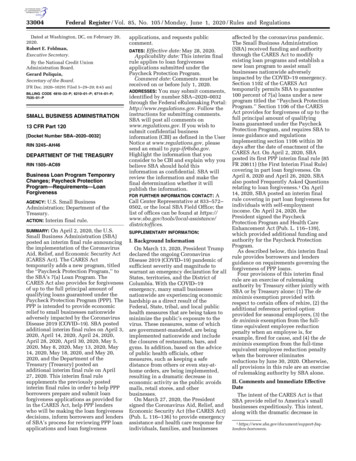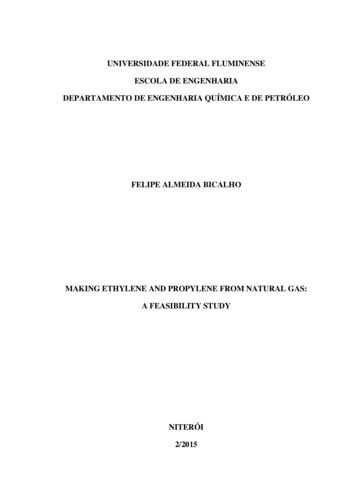
Transcription
UNIVERSIDADE FEDERAL FLUMINENSEESCOLA DE ENGENHARIADEPARTAMENTO DE ENGENHARIA QUÍMICA E DE PETRÓLEOFELIPE ALMEIDA BICALHOMAKING ETHYLENE AND PROPYLENE FROM NATURAL GAS:A FEASIBILITY STUDYNITERÓI2/2015
FELIPE ALMEIDA BICALHOMAKING ETHYLENE AND PROPYLENE FROM NATURAL GAS:A FEASIBILITY STUDYProjeto Final apresentado ao Curso de Graduaçãoem Engenharia Química, oferecido peloDepartamento de Engenharia Química e dePetróleo da Escola de Engenharia da UniversidadeFederal Fluminense, como requisito parcial paraobtenção do Grau de Engenheiro Químico.ORIENTADORESD.Sc. Ana Carla Da Silveira Lomba Sant’Ana Coutinho – TEQ-UFFPh.D. James Maneval – Bucknell UniversityPh.D. Ryan Snyder – Bucknell UniversityNiterói2/2015i
Ficha Catalográfica elaborada pela Biblioteca da Escola de Engenharia e Instituto de Computação da UFFB583Bicalho, Felipe AlmeidaMaking ethylene and propylene from natural gas : a feasibilitystudy / Felipe Almeida Bicalho. – Niterói, RJ : [s.n.], 2015.107 f.Trabalho (Conclusão de Curso) – Departamento de EngenhariaQuímica e de Petróleo – Universidade Federal Fluminense, 2015.Orientadores: Ana Carla da Silveira Lomba Sant’Ana Coutinho,James Maneval, Ryan Snyder1. Gás natural. 2. Etileno. 3. Viabilidade econômica. 4. Propeno.I. Título.CDD 665.773
ACKNOWLEDGMENTSI would like to express my very great appreciation to all the faculty and staff at FederalFluminense University and Bucknell University who provided me the possibility to complete thisfinal project and report.In particular, I give a special thanks to the Universidade Federal Fluminense Professor AnaCarla Lomba for her assistance and guidance provided and to Professors James Maneval and RyanSnyder for their valuable and constructive suggestions during the completion of my senior designproject at Bucknell University. My thanks also go to the Universidade Federal FluminenseProfessors Rosenir Rita de Cassia da Silva and Hugo Oliveira for their kind and helpful comments.I would also like to thank my friends Adam Walsh, Ana Duque Chilin and Andrew Englishfor working with me in the first version of this paper.Lastly, I want to extend my thanks to my family and all my friends who supported me incompleting this endeavor. Their words of encouragement have inspired me more than they know.ii
ABSTRACTSubstantial natural gas quantities have been found in the northern and western area ofPennsylvania, raising economic, social and political incentives to keep this gas within the UnitedStates and to find alternative uses of it besides combustion for energy production. After taking intoconsideration different possible value added products and production routes, the aim of this projectwas defined as simulate and design a production process of polymer grade ethylene and propylenefrom natural gas via methanol-to-olefins route. The overall process consists of three steps: naturalgas reforming, methanol synthesis and olefins production. The first step is contracted out, whilethe other two steps occur on-site. Synthesis gas from natural gas reforming reacts overCu-ZnO-Al2O3-12.5% CNTs catalyst under 428 ºF and 725 psia to produce methanol with 64%conversion and approximately 100% selectivity. Then, methanol reacts over H-SAPO-34 catalystsunder 710 ºF and 23.9 psia to produce olefins, leading to 98% conversion and a combinedselectivity of ethylene and propylene of 80%. Production rate of 1.6 million lbs/day of propyleneand 1.1 million lbs/day of ethylene are found to be achievable. The economic feasibility of thedesign is evaluated and has a total capital investment of 343 million. The minimum selling pricesof ethylene and propylene are calculated to be 0.56/lb and 0.52/lb, respectively, which undercutcurrent market prices, 0.65/lb of ethylene and 0.61/lb of propylene.Keywords: Ethylene, propylene, natural gas, feasibility study.iii
RESUMOQuantidades consideráveis de gás natural foram recentemente encontradas nas regiões nortee oeste da Pensilvânia, aumentndo os incentivos econômicos, sociais e políticos para manter estegás natural nos Estados Unidos, bem como encontrar alternativas para seu uso que não somente asua queima para geração de energia. Após considerar diferentes possíveis produtos e rotas deprodução, definiu-se o objetivo deste trabalho como sendo simular e projetar uma planta paraprodução de etileno e propileno a partir do gás natural através da rota metanol a olefinas. Esteprocesso é dividido em três passos: reforma do gás natural, síntese de metanol e posterior conversãoa olefinas. Decidiu-se que a reforma do gás seria contratada. O gás de síntese da reforma do gásnatural é então reagido sobre catalisadores Cu-ZnO-Al2O3-12.5% CNTs a temperatura e pressão de428 ºF e 725 psia, apresentando conversão de 64% e seletividade de aproximadamente 100% paraformar metanol. O metanol, então, reage sobre catalisadores H-SAPO-34 a 710 ºF e 23.9 psia comconversão de 98%, levando a uma seletividade combinada de etileno e propileno de 80%. Umaplanta para produção de 1.1 milhão lbs/dia de etileno e 1.6 milhão lbs/dia de propileno é projetada.A análise econômica da planta estima um investimento inicial necessário de 343 milhões. Ospreços mínimos de venda calculados são de 0.56/lb de etileno e 0.52/lb de propileno, abaixo deseus respectivos preços atuais de 0.65/lb de etileno e 0.61/lb de propileno.Palavras-chave: Etileno, propileno, gás natural, viabilidade técnica e econômica.iv
LIST OF FIGURESFigure 3.1 – Block flow diagram of the entire process on an input/output level. . 25Figure 3.2 – Block flow diagram of the process on an input/output level with recycle streams. . 28Figure 3.3 – Syngas-to-methanol reaction section. . 29Figure 3.4 – Methanol-to-olefins reaction section. 31Figure 3.5 – Syngas-to-methanol separation section. . 32Figure 3.6 – Primary water and CO2 separations of the methanol-to-olefins separation section. 34Figure 3.7 – Trace water and products separation of the methanol-to-olefins step. . 37Figure 3.8 – Composite curves of all units with a temperature approach of 10ºC. . 42Figure 3.9 – Composite curves of units E-101 and E-103. 43Figure 3.10 – Final design process flow diagram. . 44Figure B1.1 – Diagram of the compression unit C-101. . 74Figure B2.1 – Diagram of the desiccant bed unit DB-101. . 78Figure B3.1 – Diagram of the distillation unit DC-102. . 86Figure B4.1 – Diagram of the flash unit F-101. . 95Figure B5.1 – Diagram of the heat exchanger unit E-107. . 100Figure B5.2 – Diagram of the heat exchanger unit E-104. . 105Figure B6.1 – Diagram of the molten salt heater E-203. . 107v
LIST OF TABLESTable 2.1 – Global market demand for potential produced chemicals. . 16Table 2.2 – Comparison of conversions to propylene for each route. . 19Table 2.3 – Comparison of selectivities to propylene for each route. . 19Table 2.4 – Products, conversions and selectivities of methanol-to-olefins route. 20Table 2.5 – Reaction conditions of methanol-to-olefins route. . 21Table 2.6 – Input and output materials market prices. . 22Table 3.1 – Conceptual process design steps and their descriptions. . 24Table 3.2 – Stream table of the process on an input/output level in million lbs/year. . 26Table 3.3 – Breakdown of the potential profit margin of the process on an input/output level. . 27Table 3.4 – Syngas to methanol reaction section stream table. . 29Table 3.5 – Costs associated with the syngas to methanol reaction section. . 30Table 3.6 – Methanol-to-olefins reaction section stream table. . 31Table 3.7 – Costs associated with the methanol-to-olefins reaction section. . 32Table 3.8 – Syngas-to-methanol separation section stream table. . 33Table 3.9 – Costs associated with the syngas to methanol separation section. . 34Table 3.10 – Primary water and CO2 separations of the methanol-to-olefins step stream table. . 35Table 3.11 – Amine regeneration loop of the methanol-to-olefins step stream table. . 36Table 3.12 – Costs associated with the gross water and CO2 separation of the methanol-to-olefinsstep. . 37Table 3.13 – Trace water separation of the methanol-to-olefins stream table. . 38Table 3.14 – Products separation of the methanol-to-olefins stream table. . 39Table 3.15 – Costs associated with the trace water and products separation of the methanol-toolefins step. . 39Table 3.16 – Heaters and reboilers duties with their respective inlet and outlet temperatures. 41Table 3.17 – Coolers and condensers duties with their respective inlet and outlet temperatures. 41Table 3.18 – Capital and utilities costs of E-101 and E-103 before and after heat integration. . 43Table 3.19 – Final design stream table. . 47Table 4.1 – Breakdown of total bare module costs of equipment in our plant. . 54Table 4.2 – Breakdown of fixed capital investment of our plant. 54i
Table 4.3 – Breakdown of the total capital investment. . 55Table 4.4 – Breakdown of sales. . 55Table 4.5 – Breakdown of total utilities costs of equipment in the plant. . 57Table 4.6 – Breakdown of raw material costs. 57Table 4.7 – Breakdown of the direct manufacturing costs of our plant. . 58Table 4.8 – Breakdown of the fixed manufacturing costs of our plant. 58Table 4.9 – Breakdown of the general manufacturing expenses of our plant. 59Table 4.10 – Breakdown of total manufacturing costs. . 59Table 4.11 – Breakdown of the net present value calculation components. . 60Table 4.12 – Breakdown of propylene minimum selling price calculation. . 61Table B1.1 – Operating conditions of unit C-101 from HYSYS. . 74Table B2.1 – Unit DB-101 stream table from HYSYS. All units in lb/h. . 78Table B2.2 – Operating conditions for unit DB-101 from HYSYS. . 79Table B3.1 – Unit DC-102 stream table from HYSYS. All units in lb/h. . 86Table B3.2 – Operating conditions for unit DC-102 from HYSYS. . 87Table B4.1 – Unit F-101 stream table from HYSYS. All units in lb/h. 95Table B4.2 – Operating conditions for unit F-101 from HYSYS. . 96Table B5.1 – Operating conditions for unit E-107 from HYSYS. 100Table B5.2 – Operating conditions for unit E-104 from HYSYS. 105Table B6.1 – Operating conditions for unit E-203 from HYSYS. 107ii
LIST OF ABBREVIATIONSNPVNet Profit ValueMTOMethanol-to-OlefinsBFDBlock Flow DiagramPFDProcess Flow DiagramCSTRContinuous Stirred-Tank ReactorPFRPlug Flow ReactorTCITotal Capital InvestmentFCIFixed Capital InvestmentSSalesMCManufacturing CostsSVSalvageWCWorking CapitalMARRMinimum Acceptable Rate of ReturnLELLower Explosive LimitTPQThreshold Planning QuantityWCRTKWork And Community Right-To-KnowTSCAToxic Substances Control Act
LIST OF SYMBOLS𝑁𝑃𝑉Net Profit Value𝑇𝐶𝐼Total Capital Investment𝐹𝐶𝐼Fixed Capital Investment𝑆Sales𝑀𝐶Manufacturing Costs𝑆𝑉Salvage𝑊𝐶Working Capital𝑖Minimum Acceptable Rate of Return𝑛Project lifetime𝐶𝐵𝑀Bare module Costs0𝐶𝐵𝑀Bare module Costs at Base Conditions𝐶𝐶𝐹Contingency and Fee Costs𝐶𝐴𝐹Auxiliary Facilities Costs𝐶𝑂𝐿Operating Labor Costs𝐶𝑈𝑇Utilities Costs𝐶𝑊𝑇Waste Treatment Costs𝐶𝑅𝑀Raw Materials Costs𝑁𝑂𝐿Number of Operators per Shift𝐷𝐶Direct Manufacturing Costs𝐹𝐶Fixed Manufacturing Costs𝐺𝐸General Manufacturing Expenses𝐸𝑚𝑖𝑛Minimum Selling Price of Ethylene𝐸𝑐𝑢𝑟𝑟𝑒𝑛𝑡Current Selling Price of Ethylene𝑃𝑚𝑖𝑛Minimum Selling Pric
I would like to express my very great appreciation to all the faculty and staff at Federal Fluminense University and Bucknell University who provided me the possibility to complete this final project and report. In particular, I give a special thanks to the Universidade Federal Fluminense Professor Ana Carla Lomba for her assistance and guidance provided and to Professors James Maneval and .
